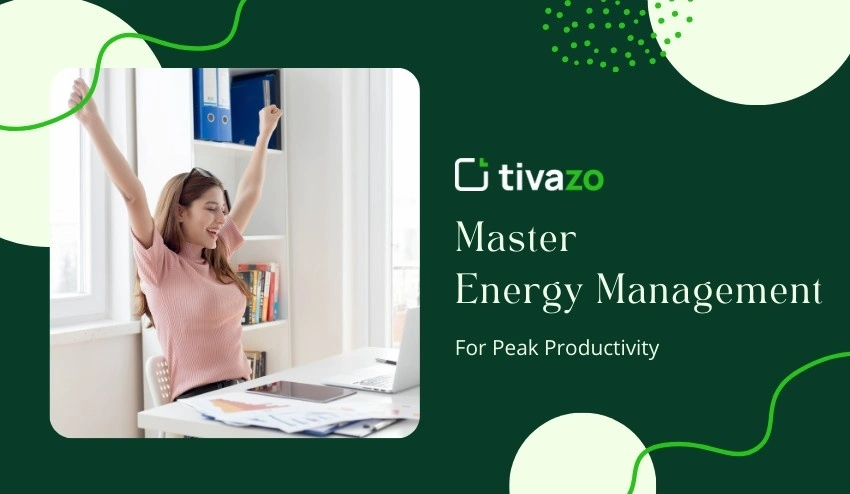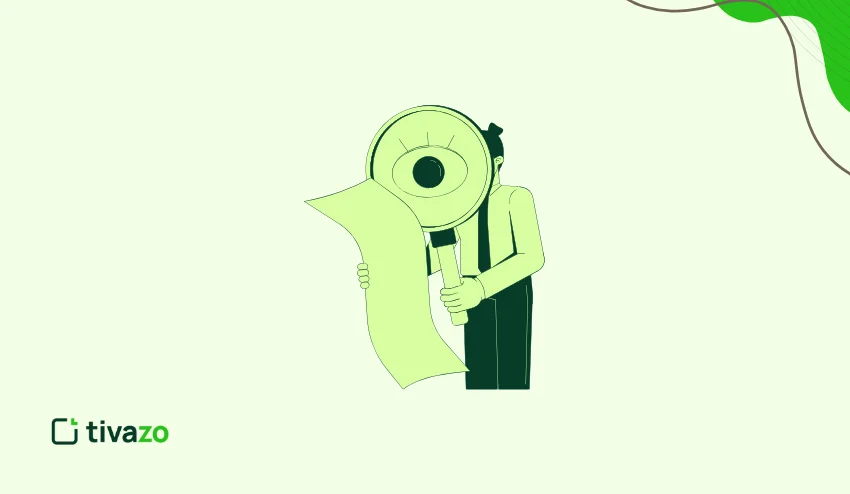Energy is not infinite, and learning how to manage it effectively is the new productivity hack. Many employees can expect to have 8 – 10 hours at work, but if they are not engaged in energy management, performance drops, stress builds, and focus fades quickly. Energy management relates to managing physical, mental, emotional, and social energy, so you can perform at your best more consistently. This guide will share 5 smart wins to help you master energy management at work and unleash your highest productivity.
Key Highlights:
- What Is Energy Management
- How to Use Energy Management
- How Energy Management Improves Workplace Productivity
- Simple Daily Habits to Boost Energy
- Digital Energy Management
- Building Long-Term Energy Resilience
What Is Energy Management and Why Does It Matter?
Energy management is the intentional practice of managing your mind, body, and emotions to perform at your best throughout the workday. Time management is about doing ‘A’ task during ‘B’ scheduled time. Energy management gets to the heart of performance with the question, “When am I capable of doing this task best, and how do I recover from performing at this level?”
It is doing the same amount of work smarter, not just longer. I want you to think of energy as a battery; everyday you have a limited amount of charging station hours. If you drain the battery on low impact work or stop recovering you won’t reach your potential and performance drops, stress rises, and you’re creativity drains. If you manage energy properly you’ll always get done what you need to in less time, keep your motivation high, and stay engaged and focused in stressful moments.
When workers value energy not simply as time, they reap the following rewards:
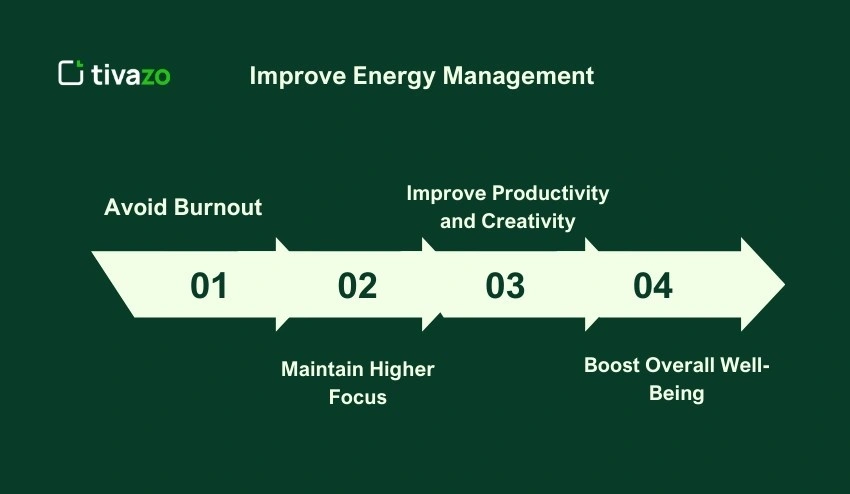
- Avoid Burnout: By matching work with energy, and knowing when to take breaks, team members avoid becoming burnt out and emotionally exhausted.
- Maintain Higher Focus During Peak Hours: we all have natural highs and lows. When you work on a complex task at a high energy point of your day, that’s maximum efficiency.
- Improve Productivity and Creativity: Good management of one s energy keeps the mind clear, which leads to better problem-solving and critical-thinking skills.
- Boost Overall Well-Being: Employees are reporting decreased stress, increased engagement, and better-equipped to manage change.
In short: Energy management is the key to consistent peak performance; sustainable productivity; and long-term career, family, and workplace engagement. It’s more than a methodology — it’s a mindset change that transforms your staff into high performers, and extremely resilient professionals.
How to Use Energy Management at Work (5 Smart Wins)
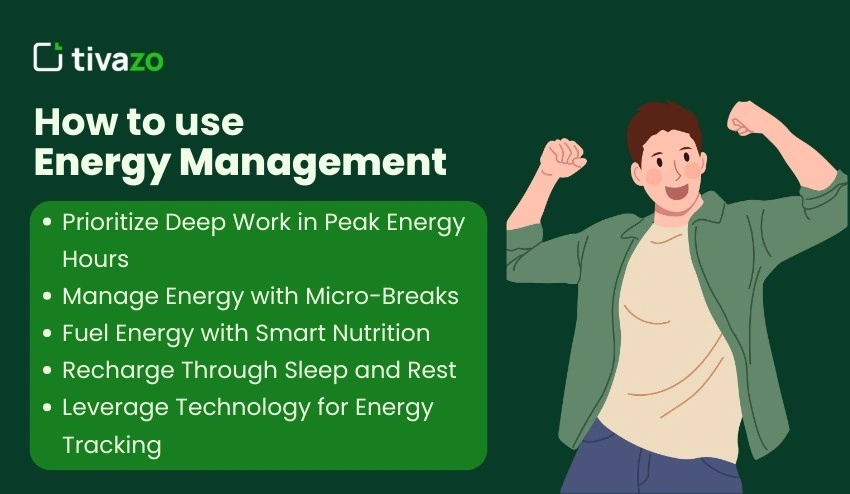
1. Prioritize Deep Work in Peak Energy Hours
Every person has natural highs and lows in energy and alertness. Some people feel alert and focused simply when they wake up, while others feel they are at their best after lunch, or even later in the day. It’s important to figure out where you fall so that you can align your peak periods with the most important work, such as the most strategic or most creative work, including strategic planning, problem-solving & writing reports, and so on. More routine tasks, less interesting tasks, and most admin tasks should be scheduled outside of these periods of peak energy.
When you have these periods scheduled as dedicated deep working periods, this means minimizing distractions, silencing notifications, and letting your team know when these periods take place, so it truly allows the brain to operate at its optimal level when it matters most. If helpful, keep a note of your energy levels for an entire week, on a scale from 1-10, to track your energy levels, so you can identify and consider intentional adjustments to your day.
2. Manage Energy with Micro-Breaks
Working for long periods at one time without a break can be very tiring for your mental and physical energy. Long task duration, which can deplete our focus and decision making and suppress creativity due to fatigue, is a major threat to the effective process management of an individual, team, department, and organization. When you break your day into short, intentional breaks, you can replenish your energy and sustain your performance. The Pomodoro method, which involves 25 minutes of focused work time followed by a 5-minute break, and is a technique supported by research to help sustain our attention and to reduce fatigue.
Any short break or organizational activity such as a walk around the office, standing up and stretching, or a short breathing exercise pro-actively engages you in resetting your cognitive energy. Even the smallest breaks restores your brain’s focus energy and creates a more productive work session and can reduce the risk of burnout over time.
3. Fuel Energy with Smart Nutrition
What you eat will have a direct relationship with your energy and attention. Foods containing refined sugars provide short bursts of alertness, but customarily lead to a crash later when you will feel tired and unfocused. If you want to maintain energy levels that are even, eating protein-rich snacks (nuts, yogurt, eggs) and staying hydrated will help your ability to concentrate and perform cognitive activities. Balanced meals containing complex carbohydrates, healthy fat, and lean protein provides energy to fuel both body and brain. Heavy lunches should be avoided as they can lead to sleepiness and sluggishness. You can better avoid dips in energy and keep focused throughout your workday by planning out meals and snacks with purpose.
4. Recharge Through Sleep and Rest
Sleep is the main key to successfully managing energy. If you are not getting sufficient rest, your reaction time will slow, memory worsens, and resilience drops, which will seldom be easy or manageable when addressing work challenges. While good quality sleep at night is extremely important, sometimes taking a break during the day can help increase energy as well. Short naps of 10–20 minutes have been proven to restore alertness, with longer naps restoring overall memory capacity, and improving focus.
Mindfulness exercises or short breaks providing a few minutes to relax will act as short-term stress minders to regain mental ability without adding emotional fatigue. Maintaining a sleep schedule consistently, even on weekends, primes the body and mind for great performance, allowing for better energy maintenance and focus while working.
5. Leverage Technology for Energy Tracking
Today’s technology offers ways to help workers monitor, analyze and optimize their energy patterns, which allows them to make informed decisions about when to work, rest, or refuel. Wearables like smartwatches can monitor sleep quality, heart rate, and activity level to give insight into one’s physical condition. Focus apps and productivity trackers may track how much attention someone pays to a task and let them know when their concentration wanes.
Even habit tracker technology can remind users to take a break, hydrate or complete some light exercises. Using technology in this way, employees can look for patterns, recognize when energy dips will happen, and manage their day to stay in the energizing zone to ensure a healthy and productive workday.
How Energy Management Improves Workplace Productivity
Workplace productivity is not about working extra hours; it is about working effectively through energy management. When employees consider how their energy patterns influence focus and structure their workday to align with high-focus periods, they greatly increase their ability to complete complex work, reduce mistakes and stay clear mentally as they move through their workday. Energy management can also help reduce employee burnout because employees will not be simply pushing themselves past their natural limits; they will have recovery periods and time for breaks strategically integrated into their work mechanic.
When a team can manage their individual energy collectively, it can result in better collaboration because the team is engaged and team’s participants will feel a greater sense of energy and emotional connection, when engaging in collaborative meetings and problem solving tasks.
When employees actively manage their energy, they can benefit in key ways:
- Focus improves: Tasks will be completed much faster and with more accuracy.
- Stress decreases: Smart scheduling and built-in recovery helps to reduce mental fatigue and overwhelmed feelings.
- Collaboration improves: Higher emotional energy means employees will be at their best and able to better accomplish out teamwork and interactions.
In one instance, a software team applied energy management techniques—planning for deep work during peak energy times, allowing teams to take micro-breaks, and tracking energy patterns—to reduce burnout by 30% and increase the rates of sprint completion by 25% in three months. That is! There is evidence that energy management not only improves individual performance, it may also affect measurable results for the organization.
Emotional Energy and Its Impact on Work
How you feel emotionally greatly influences how energized and productive you feel at work. Negative feelings—such as stress, frustration, and anxiety—can quickly deplete your energy, making it more difficult to concentrate and think clearly. Positive feelings—like motivation, enthusiasm, and fulfillment—improve mental stamina and resilience. If employees manage their emotional energy in a purposeful way, they can stay focused, improve interpersonal interactions, and be at their best. Helpers can be relatively simple in how you restore and boost this energy.
- Mindfulness exercises
- Journal/short reflection breaks
- Social support and healthy interactions with their team.
The Role of Leaders in Energy Management
Leaders are the architects of any workplace’s energy culture. While leaders are not the sole individuals responsible for creating this culture, their habits, attitudes, and behaviors are the examples set for the rest of the team. If leaders attend to their own energy by resting, managing stress, and working towards a healthy work-life balance, employees are likely to begin adopting similar practices. Factors that can influence high-energy workplaces include: providing employees with flexible work hours, offering initiatives aimed at employee wellbeing, or recognizing when employees require rest/unwind time or support.
Leadership energy is contagious: An energized and motivated manager can energize peak performance across the team, whereas a burned-out or stressed manager can easily drain energy from their teams and/or acclimate their priorities to the point where extending the leader’s stress to their team becomes an unconscious act. By practicing self-management of their energy, while also helping their team to practice self-management, the manager or leader makes it more likely that productivity, creativity, and collaboration can flourish in the workplace.
Energy Management vs. Time Management
Time is limited, but energy varies. Simply managing time can lead to long hours with little productivity. Energy-first strategies prioritize:
- Peak performance times.
- Recovery cycles.
- Sustainable performance.
In summary: Time management tells you what to do, while energy management indicates when and in which manner to undertake it.
Simple Daily Habits to Boost Energy
Our energy systems regulate how much energy we have available for work. They determine each time of day the expected amount of energy or effort required to accomplish tasks. However, we can establish daily habits to support our energy systems to assist us in maintaining energy across the work day. Implementing cycles of activities to support both physical and mental well-being a significant way to manage and even improve energy during you work day.
Simple habits like moving your body periodically throughout the day, eating balanced meals, and avoiding mental overload with too much multitasking, can support avoiding fatigue and improve all aspects of being productive. Being strategic about maintaining these habits can allow anyone to operate at a much higher level of energy and efficiency.
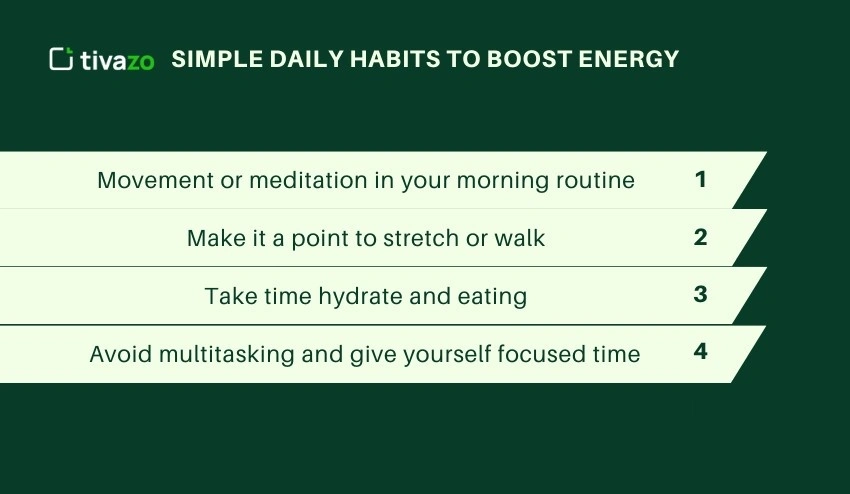
- Movement or meditation in your morning routine.
- Make it a point to stretch or walk as often as possible during the day.
- Take time hydrate. Eating consistent regular meals and snacks.
- Avoid multitasking and give yourself focused time for deep focus on your work.
Physical Workspace and Energy Flow
The physical structure you use to achieve your work is beneficial or problematic for your energy and productivity levels. Imagine the amount of attention we give to the characteristics of our work structure. The lighting, air temperature and flows, seating arrangements greatly affect how our focus is developed and can impact fatigue levels. Some potential small adjustments to your physical workspace environment can help maximize attentiveness, decrease muscular strain and possibly motivate you towards a more energizing workspace environment. As the old saying goes “what you pay attention to you create”. In this instance if you pay attention to the context you work in you can ensure it optimizes your energy and attention span.
- Lighting to reduce strain on the eyes.
- Using an ergonomically-friendly set-up to reduce fatigue (chair, desk, computer).
- Plants and natural air can increase alertness/arousal levels.
Smaller adjustments in your work area can have HUGE pay-offs in energy levels throughout your day.
Social Energy in Teams and Collaboration
The energy in a team is largely dependent on social relationships; positive relationships can create uplifting morale, motivation, and productivity, while toxic relationships can cause awful stretches of mental and emotional cowardice. Making it easy for employees to see each other as valuable, important, connected people helps keep energy high and builds collaboration. Our actions can intentionally create a kind of team culture where people feel excited, rather than depleted.
- Team check-ins that support, rather than micromanage, employees in the team.
- Peer recognition and appreciation of team members.
- Intended to decrease stress and decrease friction through clear communication.
Digital Energy Management in a Remote Era
The distance professional life has added a different kind of fatigue called digital fatigue. When the calendar fills up quickly, we forget to manage our screen time, schedule breaks, and utilize focus tools that can help us keep our energy levels high. Consider these firewall strategies.
- Avoid back-to-back Zoom calls.
- Engage “Do Not Disturb” modes during periods of deep work.
- Include buffer periods between meetings.
Building Long-Term Energy Resilience
Individuals maintain higher energy levels long term based on masses of consistent healthy behavior ongoing, not only how consistently they act healthy and follow a healthy lifestyle, instead, by the conscious principles under which they are acting. When employees develop intentional habits around nutrition, sleep, movement, and brain health to maintain resilience, they will be more productive and focused, and motivated every day. If we develop routines for our sleep, nutrition, movement, and brain, we will have energy replenishment to build a long-term foundation for performance.
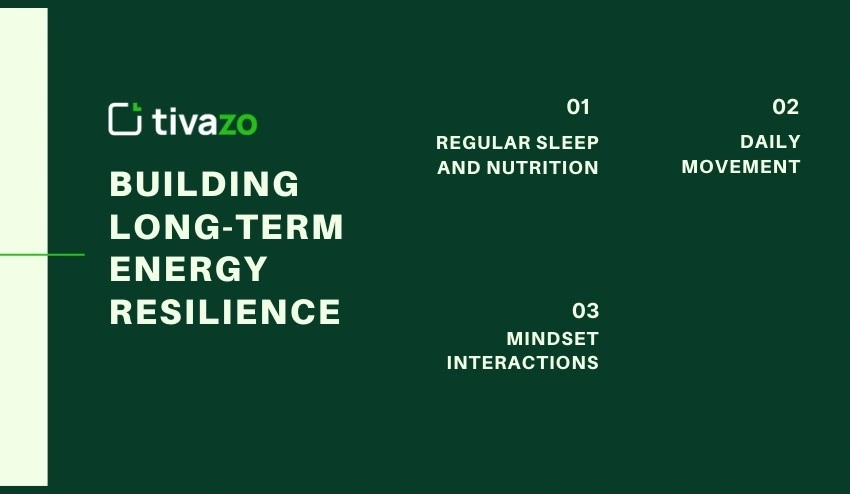
- Regular sleep and nutrition.
- Daily movement.
- Mindset interactions: focus on gratitude and wins.
We are focusing on maintaining energy long-term rather than peaks!
Future of Energy Management in the Workplace
The workplace is transforming, and energy management is becoming an important goal for organizations. The emergence of new technology, flexible working arrangements, and wellness programs are allowing employees to maximize their energy levels rather than optimize hours. Workplaces using tools and/or practices that are capable of monitoring, analyzing, and supporting human energy can continue to increase productivity, mitigate burnout, and create conditions under which employees can flourish. The future of work is maximizing human potential through effective energy management.
- Tools based on Artificial Intelligence (AI) are now available to monitor energy and program recovery.
- Hybrid work and flexible working arrangements are allowing employees to work at their optimum energy hours.
- Corporate wellness programs are focusing on integrating mental, emotional and physical energy management.
The workplace of the future is focused on human energy as opposed to hours worked.
Conclusion
Energy is becoming the new currency of productivity around the world. Management of that energy will lower stress, enhance focus, and promote sustained performance. Implementing these 5 smart wins and daily habits can reveal peak performance at work. Tools offers employee and leader tools and insights to manage energy for sustainable success.
